Neutering rabbits for disease prevention: a guide to anaesthesia
Head vet at Ark Veterinary Clinics Ltd, exotics lecturer at Glasgow University Veterinary School, and BSAVA Committee Member, Dr Madonna Livingstone BVMS MRCVS, outlines the reasons for neutering rabbits and offers a guide to anaesthesia.Surgical techniques will be outlined in a future edition
The human-animal bond is not species-specific. Rabbits are the third most popular pet in the UK and are rising in popularity globally as pets. Their average lifespan is nine to 11 years of age, and the oldest rabbit I have treated was 18. Owners bond very tightly with their rabbits; they are frequently kept indoors and training rabbits has become much more popular.
Sexing
Rabbits are relatively easy to sex. Both sexes have something that ‘pops’ out when the genital region is manipulated. It is the shape that is important.
Female rabbits have nipples which, unless they are hormonally active, will be covered with dense fur. The shape of the exposed vulva is a slit which extends right to the perineum. (Figure 1).
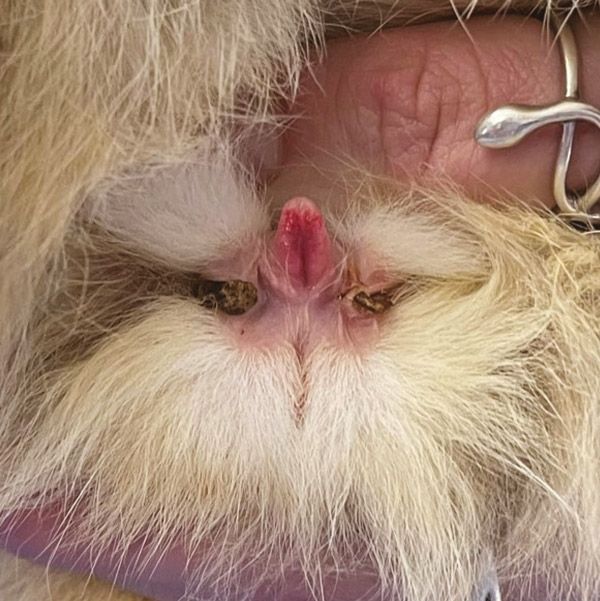
Figure 1. Female rabbit.
The presence of nipples in male rabbits is variable. The tip of the penis is circular and has been described as a doughnut shape. (Figure 2). In immature males or males that have been castrated early, it can be very easy to over evert the penis, resulting in a slit-like shape. The importance difference is that this ‘slit’ is still contained within the doughnut shape – it does not extend to the perineum. Scrotal sacs are delicate and as the inguinal canals are open, we cannot rely on the presence of testis to sex as they may have been retracted into the abdomen.
Neutering
We advise neutering rabbits for the same reasons we advise neutering any species: population control, hormonal control for behaviour, and disease prevention. I recommend neutering most rabbits at 3.5 to four months of age, the giant breeds I will leave until 5.5 to six months of age. The primary fat storage sites in does are the mesometrium and mesovarium. Spaying at a young age, before much fat has been laid down makes the procedure easier and therefore safer to perform.
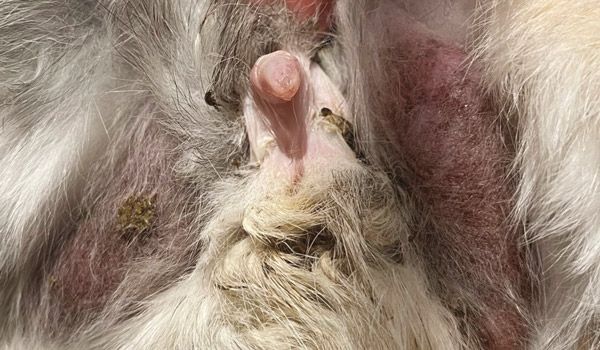
Figure 2a. Mature male rabbit
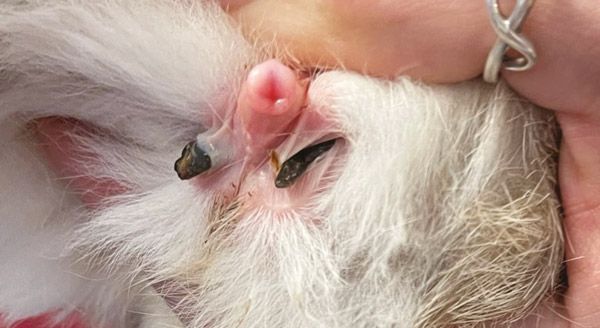
Figure 2b. Immature male everted penis.
Population control
Gestation is 28 to 32 days long. Rabbits should be kept in pairs (minimum) and the recommended pairing is a neutered male and neutered female for the best chance of success. I have seen every combination of pairing work and every combination of pairing fail. Sometimes the personality of the rabbit is the most important factor when picking a companion.
Hormonal control for behaviour
In my experience female rabbits show much more territorial aggression than male rabbits. This makes complete sense to me (despite being contradictory to some texts) from an evolutionary point of view.
In the wild, the male’s role is to mate and chase off other male rabbits. The female’s role is: dig the warren, protect the nest, have the kits, and protect the kits. The most dominant doe has the ‘safest’ nest, that is the deepest nest because predators will eat other does’ young before getting to hers. Therefore, she also has to defend the nest from other does – no wonder she displays more territorial aggression.
Neutering at 3.5 to four months of age will in most cases prevent territorial aggression from developing, however if the rabbit is already showing signs of territorial aggression, owners can be counselled that we would expect the behaviour to regress with the hormonal regression during the next six or so weeks.
Spray marking territory with urine is a common behaviour performed by both sexes although males will perform this more frequently. A rabbit who is tightly bonded to its owner may very well run round the owner’s legs while spraying urine upwards – the rabbit is only marking the human owner as important but the owner is not usually impressed! If this behaviour is fully established then, just as with other species, we cannot guarantee this will fully disappear with neutering although the frequency should decrease. If there has been a sudden increase in urine spraying then we should investigate this animal for stressors in the environment, why is this rabbit feeling the need to suddenly establish territory boundaries?
Both sexes will perform mounting behaviour which is not always sexually motivated. Sexually motivated mounting is most commonly performed by the male and can be quite aggressive performed – my friend’s male rabbit burst a football whilst mounting it. This can become a problem if the object of desire is: not interested, the household cat, the pet chicken or the owner’s leg.
After neutering, any sexually-motivated mounting would be expected to regress with the hormonal regression during the next six or so weeks.
Fighting between conspecifics can have hormonal influence. Even with surgical neutering owners may notice their rabbits mount, ‘squabble’ or seem more irritable during spring due to the ‘spring fever’ phenomenon. This is described in detail in Behavioural Problems in Rabbits: A Clinical Approach, by Guen Bradbury (ISBN: 9781789180121)
Neutering for disease prevention
Does - Ovariohysterectomy
The main condition I neuter to prevent is uterine adenocarcinoma which will occur in up to 80 per cent of unneutered does of four years of age or above. I have diagnosed uterine adenocarcinoma in a one-year-old doe. The vast majority of these will have metastasised to the lungs by the time of diagnosis. If you are suspicious of uterine adenocarcinoma already being present, radiographing the chest pre-operatively is recommended although the owners should be counselled that no obvious metastasis does not guarantee no spread, as the metastasis may be too small to see on radiograph at an early stage.
Ovariohysterectomy also prevents: ovarian neoplasia, mucometra, pyometra, false pregnancy, mastitis. All of these conditions are reported in the rabbit. Depending on age at neutering, it can also help reduce the risk of mammary neoplasia.
Bucks – Castration
Compared to uterine adenocarcinoma in the doe, testicular neoplasia is slow to metastasise and surgery at diagnosis is often curative. A firm mass will be palpable within the testis, with possible shrinking of the contralateral testis.
Testicular masses may also be: cysts or abscessation. Scrotal swelling could indicate herniation of abdominal organs. Ultrasonography and careful palpation of the area can help differentiate.
How do I anaesthetise rabbits safely?
Reducing risks associated with general anaesthesia starts before admission. This article concentrates on general anaesthesia for elective procedures in rabbits. With only a few exceptions (foreign body, bloat, or a liver lobe torsion), ill rabbits should be fully stabilised (rehydrated, passing faeces and starting to eat) before an anaesthetic should be administered.
Rabbits cannot vomit and need a near constant supply of fibre to maintain gut motility therefore they should not be starved before an anaesthetic. Owners are used to starving themselves or their dogs and cats prior to surgery, so we need to be clear when we book rabbits in for surgery that they should not be starved.
Advise owners to bring a ‘packed lunch’ of favourite and familiar foods, owners often love this phrase and I have witnessed some well-packed, personalised lunch boxes! Familiar food is important even if it is not ideal, for example, muesli. Once the pet has recovered, that is the time to gradually change the diet to a more advisable one.
The bond between rabbits is scent-based. Failure to admit the bonded cage mate can result in: stress-induced anorexia (in either or both rabbits), the breakage of the bond, fighting, injuries, and upset owners. It may also be difficult to re-bond the rabbits. I always advise admitting the bonded cage mate at the same time. Owners are, in my experience, happy to bring the cage mate in once they understand why.
Hospitalisation/ward set up
There are several factors to take into consideration in relation to rabbits as a prey species extremely sensitive to stress caused by the sight, sound and smell of predators. Stress is immunosuppressive for any species and as such we should aim to minimise it.
In an ideal world, we would all have prey species wards. For many practices, that is not the reality. Other options include: setting up pens/collapsible kennels in a quieter area of the clinic or utilising the cat ward, provided the kennels are not facing each other.
The ward should be kept warm, but care should be taken not to heat above 22oC as above this temperature heat stroke becomes a real risk. I aim to keep my ward between 18-20oC as this ensures the animal is not having to expend energy to stay warm. A digital max/min thermometer and hygrometer (which can be purchased inexpensively) allows me to monitor the temperature and the humidity within the room.
Prey species do not like absolute silence. In the wilderness, there is always birdsong or other animal noises unless there is a predator around. For this reason, playing music at a low level is recommended. At the time of writing, a rabbit-specific appeasement pheromone is not available to the veterinary/pet trade. I use Pet Remedy (Pet Remedy Ltd) plug-ins in each of my wards to attempt to mitigate the stress of hospitalisation.
How the kennel/pen is set up is also important. Slippery surfaces are stressful and can result in injuries. Lining the floor with paper and providing a deep bed of hay is a good choice. If the rabbit is used to having blankets or towels at home, then they can also be used.
A litter tray with a familiar substrate should be given if the rabbit is litter-trained. I have learnt from bitter experience that some rabbits will not pass faeces if they are not given a tray. A hide should be provided, this can consist of a cardboard box or can even be achieved by covering half the front of the enclosure with a blanket.
Providing both water bottles and heavy earthenware water bowls (helps prevent spillages) can encourage water intake. Freshly-picked grass should be offered to every inpatient and will act as an appetite stimulant to many rabbits.
Pre-anaesthetic blood tests
The need for these is debated among vets. Personally, I advise they are an option but acknowledge that, in the young healthy individual, the vast majority will be within reference ranges. The benefit is that it will give you a personalised reference range for this individual patient and as rabbits are so good at hiding disease, occasionally we get unexpected results which may alter our plans.
Blood can be taken from the marginal ear vein, cephalic vein or the lateral saphenous vein. The jugular is not commonly used in rabbits due to the short neck and presence of a dewlap in many. There is nothing wrong with aseptically dripping the blood from a needle into the collection tube (see Figure 3). Even in a 1kg rabbit, you can safely take up to 8ml of blood – we only need 1ml to run a profile. Biochemistry can be run ‘in-house’ using the same pre-op profiles used for dogs and cats. See Table 1 for reference ranges.

Table 1. Pre-op rabbit reference ranges.
Pre-emptive analgesia/prokinetics
Once admitted, administer meloxicam 0.6-1mg/kg and metoclopramide 1mg/kg. These can either be given orally or by s/c injection (see Table 2).
Intravenous catheter placement
Wrapping the rabbit in a towel using EMLA cream (contains lidocaine and prilocaine) makes venipuncture much easier.
My vein of choice is the marginal ear vein, which is located on the dorsal aspect of the pinna running parallel to the lateral margin of the pinna.
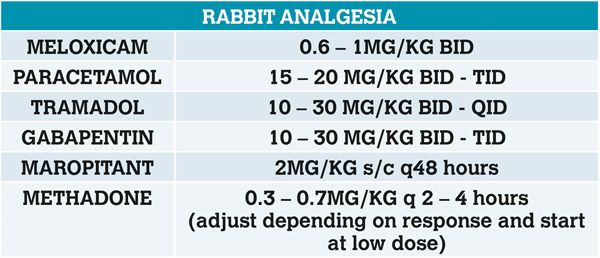
Table 2. Rabbit analgesia.
As with more familiar species, one vein is often bigger than the other, therefore I clip fur over the vein in both pinnae. I apply an approximately 1mm-thick layer of EMLA, enough so there is a noticeably white patch, then I get the rest of my equipment organised. In my experience, EMLA takes around five minutes to cause venodilation, some local anaesthesia and does not require a dressing to work. Pick your catheter size judged on the size of the vein, not the size of your patient. For most rabbits, I will end up using a 26g IV (purple in UK) catheter, but for the bigger rabbits I have used up to a 20g (pink in the UK).
Placing IV catheters in rabbits is extremely easy. The ear vein is fixed in place by the skin (therefore, it does not ‘bounce’) and it is very superficial. Winged catheters are much easier to tape in as you can bend one wing around the edge of the pinna. Dressing tape such as Micropore (3M) is applied proximal and distal to the cannula in exactly the same manner we would in our canine patients. I do not use bandaging materials inside the pinnae or over the cannula. In my experience, the added weight from these materials can irritate the rabbit and increase the likelihood that the patient removes their cannula.
Alternative sites for IV catheter placement are: cephalic vein or lateral saphenous vein.
The cephalic vein is popular with many vets but I tend to only use it for blood sampling as rabbits are much more likely to chew IV catheters out of this site.
General anaesthesia
There are several anaesthetic protocols available for use in rabbits. There is an argument to be made that the safest anaesthetic is the one you are used to. That being said, it has been recognised for at least twenty years, mask induction of rabbits is not recommended and will increase risk of death. This is due to breath holding, severe stress and sensitisation of the myocardium to catecholamines.
I have used a triple combination of medetomidine, butorphanol and ketamine as my anaesthesia cocktail of choice for twenty years. All I have changed over the years is the dose and route of administration. We should be aware that the only licensed ketamine for rabbits in the UK is Anaestamine (Animal Care).
I mix: 0.1ml/kg medetomidine (1mg/ml), 0.05ml/kg butorphanol (10mg/ml), and 0.05ml/kg ketamine (100mg/ml), in a syringe. I give slowly IV to effect, which usually is a third to half of the volume. Triple combination also provides multimodal analgesia.
Alfaxan (alfaxalone, Jurox) is licensed for use in rabbits above 16 weeks of age and for use as an induction agent prior to inhalational anaesthesia. Pre-oxygenation is advised, as life threatening hypoxaemia can occur secondary to apnoea. Intubation should be performed as soon as possible to provide oxygen and intermittent positive pressure ventilation, if required. The analgesic properties of alfaxalone are limited, therefore other means of analgesia will be required.
The large cornea should be protected by applying an ocular lubricant.
Intubation
Intubation of the rabbit is dependent on the reasons for anaesthetising the rabbit. Personally, I will only intubate for: head surgery (not dentals), abdominal or thoracic surgery, or a procedure which will last longer than fifteen minutes. I do not routinely intubate for routine castrations.
Although many clinicians perform blind intubation in rabbits, this makes me uncomfortable due to the risks of foreign bodies being pushed into the trachea (see Figure 4). I prefer to intubate using direct visualisation of the glottis.
With the rabbit in ventral recumbency, an assistant flexes the head vertically so that the nose of the rabbit is aimed toward the ceiling and lifts the head. The front legs of the rabbit should be dangling just off the table. A long, sterile otoscope cone is introduced into the diastema and directed down the throat. The amount of pressure required (you need to direct the cone vertically and centrally) and the depth of the glottis can make this intimidating. The tongue will sometimes go blue due to venous congestion caused by the scope (see Figure 5).
The epiglottis will be seen sitting over the glottis and can be disarticulated by touching it with the cone. A local anaesthetic spray such as Intubeaze (20mg/ml Lidocaine hydrochloride monohydrate, Dechra) is applied to the glottis (see Figure 6).
Most rabbits require a size 2.5 uncuffed endotracheal (et) tube.
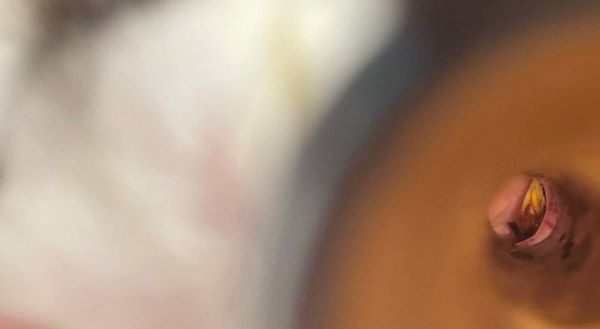
Figure 4. Grass seed at trachea of rabbit.
I will have three sizes available: 2, 2.5, and 3. Judge the size of the tube required based on the size of the glottis, just as we do in dogs and cats.
An uncuffed et tube (remove the connector first) is guided down the cone, into the trachea. Alternatively, a dog urinary catheter can be used as a guide wire. Place the urinary catheter into the trachea, remove the otoscope and feed the et tube over the urinary catheter and into the trachea. Reattach the connector. Check for air movement from the tube to ensure correct placement has been achieved. Fix in place with a tie.
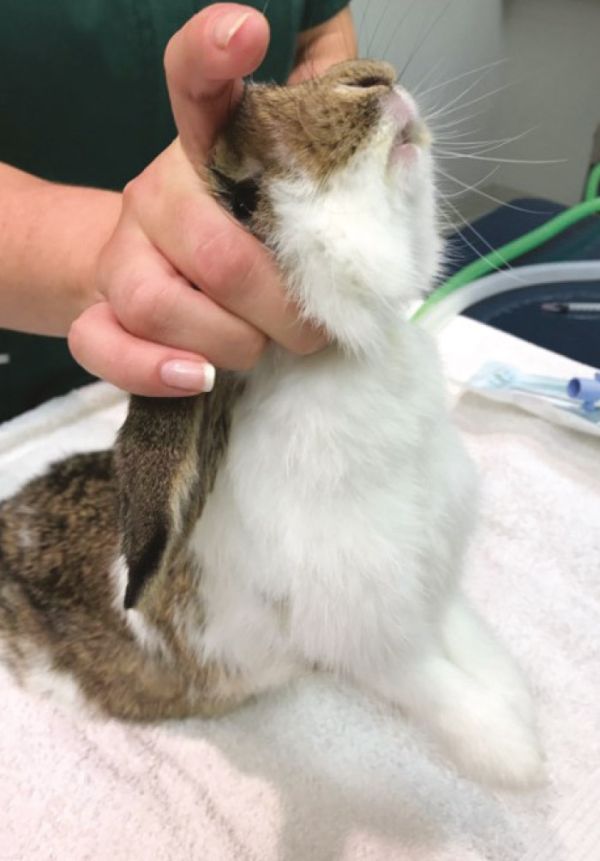
Figure 5a. Position for rabbit intubation.
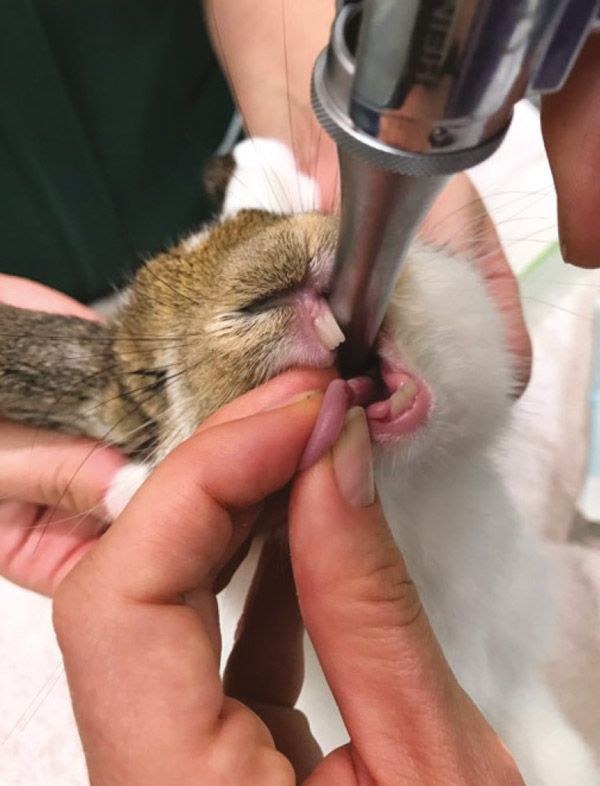
Figure 5b. Position for rabbit intubation.
I have a ‘three tries rule’. If I cannot get the et tube placed on the third attempt, I stop and use a facial mask, ensuring the nares are not occluded. Repeated attempts can result in trauma, oedema and laryngospasm.
Some practices now have rabbit V gels. These are specially designed tubes which, when placed, sit on top of the glottis.

Figure 6. Rabbit glottis.
It is recommended to use them with capnographs to ensure they have not moved. I do not use them and have heard multiple anecdotal reports of them moving out of place during surgery, however they can be placed quickly which is of benefit in an emergency.
Maintenance
I use a T-piece circuit, with an oxygen flow of 1.5-2L/min. Some rabbits will not require isoflurane (my gaseous anaesthetic of choice) as the induction cocktail may be enough for the procedure. More of the induction triple combo can be administered to deepen the anaesthesia or isoflurane 2-4 per cent as required.
Monitoring
Monitoring the anaesthetic is the same as for more familiar species, except there may still be a faint pedal in the front leg even with surgical depth anaesthesia. Many texts mention the palpebral reflex remains, however when ketamine is used there will be no blink. If using a pulse oximeter, please remember that medetomidine can cause peripheral vasoconstriction leading to inaccurate results in some patients, although in my experience if placed on the tongue I get good readings.
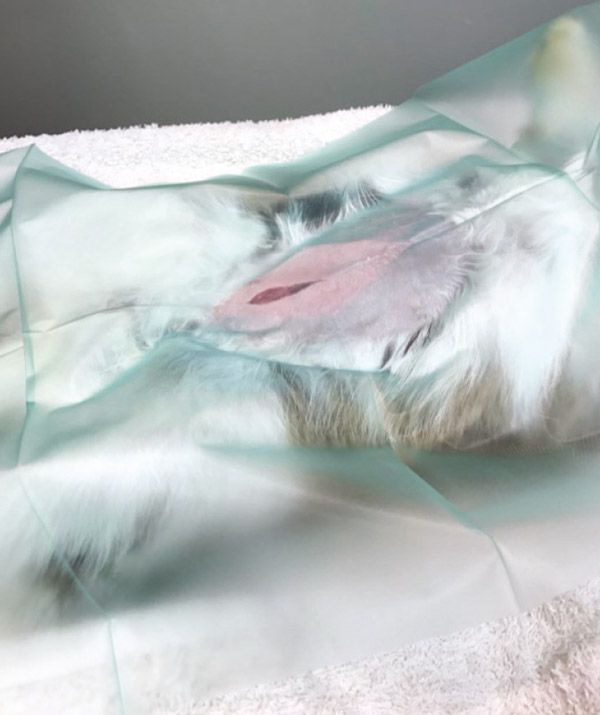
Figure 7a. Plastic drape spay rabbit.

Figure 7b. Plastic drape.
Theatre
Rabbits have a high surface area to volume ratio which means they lose heat rapidly. The resulting hypothermia can cause fatalities. Keeping the ambient temperature in theatre high, wrapping the extremities (including the ears) in bubble wrap, and placing a towel on the operating table are all easy ways to help mitigate heat loss. Minimise the number of times the door is opened as each time it happens the ambient temperature in the room will drop.
Rabbits are diaphragmatic breathers. Their small thoracic cavity, in comparison to their large abdominal cavity, can make breathing more difficult due to the weight of the abdominal organs sitting against the diaphragm. Placing a folded towel under the thorax elevates the thorax and allows the abdominal organs to move away from the diaphragm.
Surgical preparation
Rabbit skin is delicate and can be traumatised by inappropriate (and sometimes even appropriate) clipper technique. To conserve body temperature, minimise the surgical clip. Only one agent is used for surgical scrub, either chlorhexidine or an iodine-based skin disinfectant, depending on the surgeon’s preference. We do not use a surgical spirit-based spray as during evaporation this causes loss of heat.
Transparent, plastic surgical drapes are ideal as they allow visualisation of the rabbit while conserving body heat. The required surgical window can be cut into the drape and a surgical spray adhesive is used in lieu of towel clips (see Figure 7).
Recovery
Medetomidine can be reversed with 0.1-0.5ml/kg atipamezole (5mg/ml) s/c, reversing the medetomidine will also reverse the analgesia provided by medetomidine but that is not reason enough for not reversing.
Maintain the rabbit on oxygen, and if intubated, extubate when the jaw tone increases. Shivering thermogenesis is a sign of recovery from anaesthesia. Continue to monitor while in an incubator or a warm room (ideally around 26oC) until up and moving, then the temperature of the room can be reduced to 20oC. Research by Broadbelt (2006), found that 64 per cent of the perioperative deaths occurred during the post-operative recovery, so close monitoring until the rabbit is ambulatory is ideal.
Syringe feed (10-20ml/kg Oxbow Recovery, Science Recovery or EmerAid Herbivore) once the rabbit is fully conscious and monitor faecal output. Advise the owner to monitor food intake and faecal output. If the owner is unable to syringe feed at home, then they must bring the rabbit back to the practice as soon as possible for admission if it will not eat at home. In the vast majority of cases with good analgesia, this will not be an issue (see Table 2).
Conclusion
Rabbits really do not deserve the reputation of always dying/being high risk under general anaesthesia. Risks can easily be minimised even in the busiest of first opinion practices and prey species can be incorporated into any practice with a little bit of lateral thinking. Understandably, owners are now expecting the same high level of care for their pet rabbit as for their dogs and cats.
References available on request.
1. It is easy to perform sexing rabbits if we remember that:
A. It is only the male rabbit that has something ‘pop’ out when the genitals are manipulated.
B. It is the shape of the tissue that ‘pops’ out that is important. The female has a slit and the male has a doughnut/circle.
C. It is the shape of the tissue that ‘pops’ out that is important. The female has a doughnut/circle and the male has a slit.
D. Only female rabbits have nipples.
2. Rabbits should not be starved before surgery. Why is this statement correct?
A. Rabbits should be starved before surgery; the statement is incorrect.
B. Rabbits should not be starved before surgery as they are at risk of hypoglycaemia.
C. Rabbits should not be starved before surgery as they will become dehydrated.
D. Rabbits should not be starved before surgery as they cannot vomit and need constant throughput of fibre to keep their gut motility regular.
3. How can we minimise stress for the rabbit in the clinic?
A. Admit the cage mate, keep out of sight, sound, and smell of predators, ensure non slip surfaces, careful handling, adequate analgesia, provide familiar food, Pet Remedy plug in.
B. Send the cage mate home, keep out of sight, sound, and smell of predators, ensure non slip surfaces, careful handling, adequate analgesia, provide familiar food, Pet Remedy plug in.
C. Admit the cage mate, keep out of sight, sound, and smell of predators, careful handling, adequate analgesia, provide familiar food, Pet Remedy plug in.
D. Admit the cage mate, keep out of sight, sound, and smell of predators, ensure non slip surfaces, careful handling, adequate analgesia, provide familiar food.
4. Rabbits deserve the same high-quality care as more familiar species and owners are expecting their usual vet to be able to deliver this because:
A. Rabbits are the third most common mammalian pet which is only a fairly recent development.
B. Owners have unrealistic expectations of vets.
C. Rabbits are the third most common mammalian pet, have been for many years, the human animal bond is not species-specific.
D. Rabbits are the third most common mammalian pet but owners are unwilling to investigate or treat.
5. Good analgesia is important even though pain can be challenging to assess in prey species. It is important that we consider:
A. If, for example, a dog or cat (or we!) would find this procedure/condition painful, we appreciate that rabbits will find it painful and give pre-emptive analgesia. Failure to provide adequate analgesia is a welfare concern.
B. If for example a dog or cat would find this procedure/condition painful, we appreciate that rabbits probably will not find it painful.
C. Anthropomorphism is unprofessional and if rabbits are hiding the pain it cannot be that bad.
D. If for example a dog or cat (or we!) would find this procedure/condition painful, we appreciate that rabbits will find it painful and give pre-emptive analgesia. Failure to provide adequate analgesia is a welfare concern. In rabbits, pain anywhere can have catastrophic effects on gut motility.
ANSWERS: 1B; 2D; 3A; 4C; 5D.














